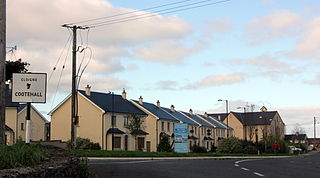
Earl of Kingston is a title in the Peerage of Ireland. It was created in 1768 for Edward King, 1st Viscount Kingston. The Earl holds the subsidiary titles Baron Kingston, of Rockingham in the County of Roscommon, Viscount Kingston, of Kingsborough in the County of Sligo, Baron Erris, of Boyle in the County of Roscommon, and Viscount Lorton, of Boyle in the County of Roscommon, also in the Peerage of Ireland. He is also a baronet in the Baronetage of Ireland. Between 1821 and 1869 the earls also held the title Baron Kingston, of Mitchelstown in the County of Cork, in the Peerage of the United Kingdom.
Tenison or Tennison is a surname. Notable people with the surname include:

The Cavan & Leitrim Railway was a 3 ft narrow gauge railway in the counties of Leitrim and Cavan in northwest Ireland, which ran from 1887 until 1959. Unusually for Ireland, this 3 ft narrow gauge line survived on coal traffic, from the mine at Arigna. It outlived most of the other Irish narrow-gauge lines, giving a further lease of life to some of their redundant engines.
General Robert Edward King, 1st Viscount Lorton, styled The Honourable from 1797 to 1800, was an Anglo-Irish peer and politician. He was notable for his strong support for anti-Catholic policies and his close association with the Orange Order.

Kinnitty Castle or Castle Bernard is a 19th-century gothic revival castle in Kinnitty, County Offaly, Ireland. It is located north of the Slieve Bloom Mountains on the R421 regional road between the villages of Kinnitty and Cadamstown. A nearby pyramid was built by the Bernard family who resided in the castle.

Thomas William Anson, 1st Earl of Lichfield PC, previously known as The Viscount Anson from 1818 to 1831, was a British Whig politician from the Anson family. He served under Lord Grey and Lord Melbourne as Master of the Buckhounds between 1830 and 1834 and under Melbourne Postmaster General between 1835 and 1841. His gambling and lavish entertaining got him heavily into debt and he was forced to sell off the entire contents of his Shugborough Hall estate.

Ripley Castle is a Grade I listed 14th-century country house in Ripley, North Yorkshire, England, 3 miles (4.8 km) north of Harrogate.

Temple House is a Georgian mansion set in a family estate of over 1,000 acres (400 ha) overlooking the lakeside ruins of a Knights Templar castle and is now a luxury country guest house, like a hotel. Originally built in c. 1825, it was substantially extended and embellished c. 1864.
The High Sheriff of King's County was the British Crown's judicial representative in King's County, Ireland from 1556, when King's County was created, until 1922, when the office was abolished in the new Free State and replaced by the office of Offaly County Sheriff. The sheriff had judicial, electoral, ceremonial and administrative functions and executed High Court Writs. In 1908, an Order in Council made the Lord-Lieutenant the Sovereign's prime representative in a county and reduced the High Sheriff's precedence. However the sheriff retained his responsibilities for the preservation of law and order in the county. The usual procedure for appointing the sheriff from 1660 onwards was that three persons were nominated at the beginning of each year from the county and the Lord Lieutenant then appointed his choice as High Sheriff for the remainder of the year. Often the other nominees were appointed as under-sheriffs. Sometimes a sheriff did not fulfil his entire term through death or other event and another sheriff was then appointed for the remainder of the year. The dates given hereunder are the dates of appointment. All addresses are in King's County unless stated otherwise.
The High Sheriff of Louth was the Crown's representative for County Louth, a territory known as his bailiwick. Selected from three nominated people, he holds his office over the duration of a year. He has judicial, ceremonial and administrative functions and executes High Court Writs.
The High Sheriff of Roscommon was the British Crown's judicial representative in County Roscommon, Ireland from 1575 until 1922, when the office was abolished in the new Free State and replaced by the office of Roscommon County Sheriff. The sheriff had judicial, electoral, ceremonial and administrative functions and executed High Court Writs. In 1908, an Order in Council made the Lord-Lieutenant the Sovereign's prime representative in a county and reduced the High Sheriff's precedence. However the sheriff retained his responsibilities for the preservation of law and order in the county. The usual procedure for appointing the sheriff from 1660 onwards was that three persons were nominated at the beginning of each year from the county and the Lord Lieutenant then appointed his choice as High Sheriff for the remainder of the year. Often the other nominees were appointed as under-sheriffs. Sometimes a sheriff did not fulfil his entire term through death or other event and another sheriff was then appointed for the remainder of the year. The dates given hereunder are the dates of appointment. All addresses are in County Roscommon unless stated otherwise.
Richard Tenison was an Irish bishop of Killala, Clogher and Meath.

Cootehall is a village in County Roscommon, Ireland. It is located on the River Boyle, between Boyle and Carrick-on-Shannon near Lough Key Forest Park in the north of the county.

Richhill Castle is a 17th-century Grade A listed country house in the large village of Richhill, in the townland of Legacorry, Armagh, Northern Ireland roughly halfway between Armagh and Portadown.
Robert King, 6th Earl of Kingston, styled The Honourable until 1854, was an Anglo-Irish politician and peer.
Edward King Tenison was an Irish Whig and Liberal politician and photographer.











